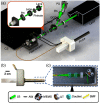Transvaginal fast-scanning optical-resolution photoacoustic endoscopy
- PMID: 30520276
- PMCID: PMC6279961
- DOI: 10.1117/1.JBO.23.12.121617
Transvaginal fast-scanning optical-resolution photoacoustic endoscopy
Abstract
Photoacoustic endoscopy offers in vivo examination of the visceral tissue using endogenous contrast, but its typical B-scan rate is ∼10 Hz, restricted by the speed of the scanning unit and the laser pulse repetition rate. Here, we present a transvaginal fast-scanning optical-resolution photoacoustic endoscope with a 250-Hz B-scan rate over a 3-mm scanning range. Using this modality, we not only illustrated the morphological differences of vasculatures among the human ectocervix, uterine body, and sublingual mucosa but also showed the longitudinal and cross-sectional differences of cervical vasculatures in pregnant women. This technology is promising for screening the visceral pathological changes associated with angiogenesis.
Keywords: cervical imaging; fast scanning; microelectromechanical system scanning mirror; optical-resolution photoacoustic endoscopy.
(2018) COPYRIGHT Society of Photo-Optical Instrumentation Engineers (SPIE).
Figures







References
Publication types
MeSH terms
Grants and funding
LinkOut - more resources
Full Text Sources
Medical

